During the months leading up to the 2019 NHL Draft, the media focused on who would be the first-overall pick: American Jack Hughes or Finnish superstar Kaapo Kakko? Following that, the headline story was the eight first-round picks selected from the US National Team Development Program (USNTDP), including Hughes as the number one pick. That was a record number of first-rounders picked from one team in the NHL Draft, which prompted me to write my June 28, 2019 article about the USNTDP.
The article led me to conduct a more thorough study of the draft results over the last 10 years, focusing on the nationalities of drafted players and the breakdown of the picks selected from the three leagues that make up the Canadian Hockey League (CHL): the Western Hockey League (WHL), the Ontario Hockey League (OHL), and the Quebec Major Junior Hockey League (QMJHL).
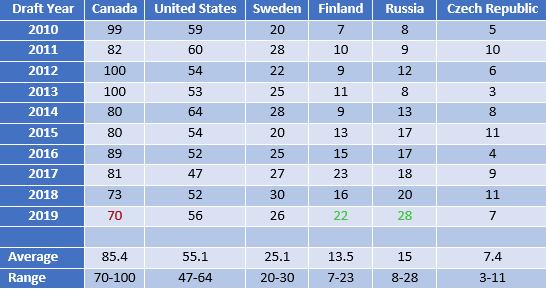
USNTDP, Finns, and Russians Dominate
Even though the United States had a record number of first-round draft picks from the USNTDP, the total number of US-born players drafted this year was 56. That number was close to their 10-year average of 55.1 players. The same was true for both Sweden and the Czech Republic that had 26 and seven players selected, respectively, also close to their 10-year averages.
The 2019 NHL Draft was a great draft for players born in Finland and Russia. The Finns contributed 22 players, including the second-overall pick, Kakko, to this year’s draft class, second only to the 2017 Draft when 23 Finns were selected. NHL teams found Russian born prospects attractive this year, choosing 28 players. It was the highest number of picks from Russia in the last 10 years, bettering last year’s previous high of 20 players.
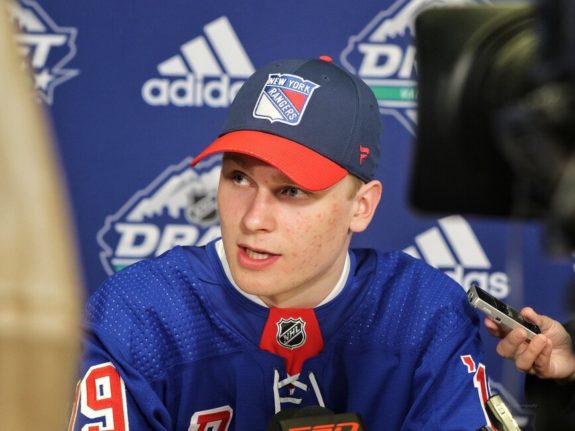
NHL general managers and their scouting staffs did not favor Canadian born players this year. They selected a record low of 70 players, 30 percent less than the 100 chosen in both the 2012 and 2013 Drafts. The number of Canadians drafted has been trending down, especially in the last three years.
Over the last four years, the first-overall pick has been American, Auston Matthews in 2016 and Hughes in 2019, or European, Switzerland’s Nico Hischier in 2017 and Sweden’s Rasmus Dahlin in 2018. This recent trend follows a period when Canada produced the first-overall pick in five of six drafts from 2010 to 2015, including Taylor Hall, Ryan Nugent-Hopkins, Nathan MacKinnon, Aaron Ekblad, and Connor McDavid.
CHL Model Is Being Challenged
According to the CHL website, “The Canadian Hockey League is the world’s largest development hockey league (and)…supplies more players to the National Hockey League than any other league”. That may be true, but they are now being challenged by new and improved player development programs like the USNTDP, and vastly improved hockey models in European countries. The result was a record low number of CHL draft picks this year in favor of US and European prospects.
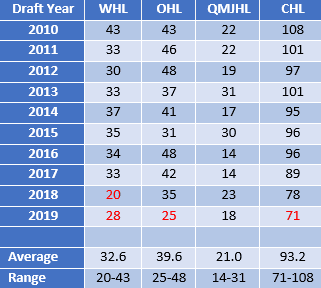
After the nationality study, I decided to drill down on the CHL success rate at the draft. They produced the fewest number of picks in the last 10 years at 71. That is 35 percent lower than the 108 players selected in the 2010 Draft. The number of players chosen has been trending sharply lower over the past three years. According to The London Free Press, “There were three NHL clubs (Boston, Winnipeg and Detroit) who didn’t touch a skater from the CHL during the (2019 Draft),” (from ‘ANALYSIS: US program won 2019 NHL draft, but OHL in for bounce-back’, The London Free Press – 6/24/19).
The last two drafts have been the worst in 10 years for the WHL with 20 picks in 2018 and 28 this year. That equates to a 35 percent drop in 2019 from the high of 43 players drafted from the league in 2010. Despite the lower numbers, the WHL led the CHL with both the highest total number of picks and the number of players selected in the first round at seven, led by third-overall pick Kirby Dach of the Saskatoon Blades.
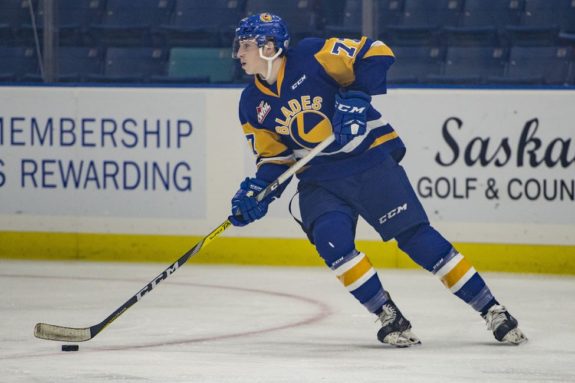
The 2019 Draft was the worst in the last 10 years for the OHL with only 25 players selected. That number was down 48 percent from the high of 48 picks in 2012, trending downward the last three years. The first pick from the OHL was defenceman Thomas Harley from the Mississauga Steelheads who was picked 18th overall. The OHL produced a record low four first-round picks this year.
The QMJHL generated 18 picks, which was slightly lower than the league average of 21 picks over the last 10 years. The league only produced two first-round picks with the Sherbrooke Phoenix’s Samuel Poulin leading the way as the Q’s first overall pick at 21st.
Measuring Success at International Tournaments
Many hockey experts will argue that the number of players drafted into the NHL is the best measure of success for player development leagues. Others claim that the history of achievement at the international level is the real litmus test of a country’s development model. The marquee tournaments that countries use to evaluate their programs on the international stage are the IIHF U-18 and U-20 World Hockey Championships.

The US has dominated the U-18 tournament with six gold medals in the last 10 years, and they have medalled every year. The USNTDP U-18 Team uses the tournament as its vital measure of player development success. Canada has not enjoyed the same degree of success, winning only four medals in the last 10 years. Over that period they won only one gold medal, and they have not been on the podium in the last four years.
Sweden and Finland have both medalled in six of the last 10 years. Sweden captured the gold as the host country this year while Finland has won two gold medals over the last four years. Russia and the Czech Republic have enjoyed minimal success at the U-18 tournament over the previous 10 years.

Russia has enjoyed more success at the U-20 tournament, amassing a total of eight medals over the last 10 years, including one gold medal. The US has medalled in seven of the previous 10 tournaments, including three gold medals and medals in each of the last four years.
Finland has dominated the tournament in the last six years. They won three gold medals over that period, while rival Sweden has won only one medal in the previous five years, after medalling in four of five years from 2010-2014. The Czech Republic has not won a medal during the last 10 years.
Canada has had some success at this tournament medalling in six of the last 10 years, including a gold medal in 2018. However, they have not won a medal in two of the previous five years. The 2019 tournament was a bitter disappointment for Team Canada. CBC Sports summed up the defeat best: “The defending champions were ousted from the world junior hockey championship after a dramatic 2-1 overtime loss to Finland. It’s the first time Canada has not won a medal when hosting the tournament and only the second time in 21 years that Canada will not play for a medal at the world juniors.”
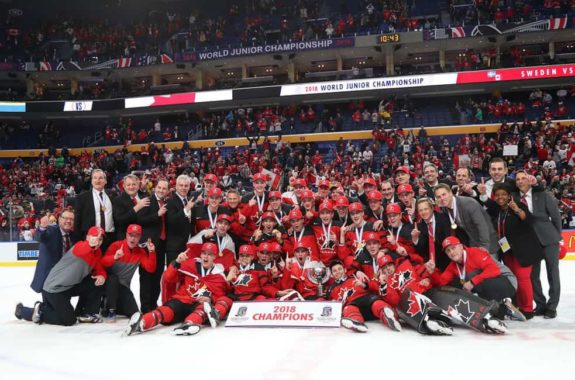
The 10-year data on the nationalities of NHL draft picks and the success of other participant countries at both the IIHF U-18 and U-20 World Hockey Championships point to the fact that Canada’s competitive advantage is waning. The country’s success in elite international tournaments and its dominance in producing NHL draft prospects appears to be vulnerable. The USNTDP and the new European development models initiated by countries like Russia, Finland, and Sweden are challenging Canada’s dominance at the draft table and in international competition.
According to Pierre Page, a former NHL general manager and coach, and the past Global Sports director/Head coach Red Bull Global Hockey Academy, the main reason these countries are catching up to Canada is that they promote practice and skill development more than the number of games played. This philosophy differs considerably from the CHL which supports a focus on playing 60-80 games a season to improve player development.
The common thread Page says is, “These programs believe that younger players will only get better if they consistently play against older players. The USNTDP U-18 Team plays against older players in the USHL and Division I NCAA. The 16, 17, 18, and 19-year-old elite players in Sweden, Finland, and Russia are playing in the professional leagues in Europe against better skilled, more mature players. That is how they get better. Jack Hughes and Kappo Kakko are great examples of what these programs are doing to develop elite talent,” (interview July 15, 2019).
What are the critical components of these successful models and why are they enjoying notable success in developing young players? That will be the subject of another article.